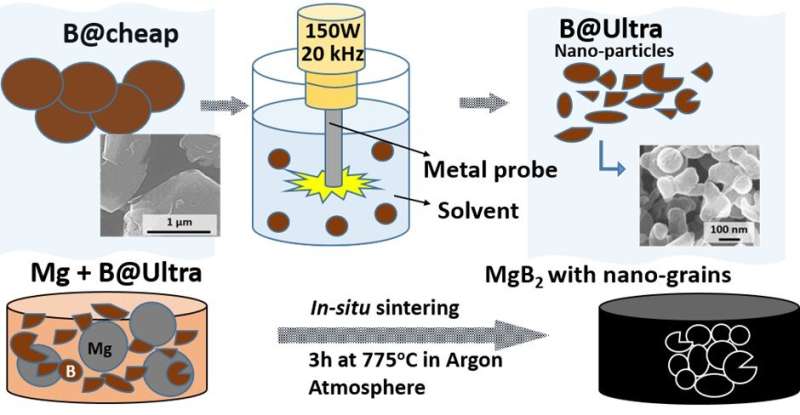New refining technique makes cheaper superconductors a reality

Superconductors could potentially phase out bulk magnets in machinery ranging from MRIs and CT scanners to electric motors. The catch? Conventional high-temperature superconductors are made up of expensive rare earth metals and have a long and complicated fabrication process. This has caused attention to shift to superconductors manufactured from magnesium diboride (or MgB2), which is lightweight, cheap, and easier to fabricate and mold into intricate shapes.
Previous research has shown that using nanoscale boron to make MgB2 results in better magnetic characteristics. However, commercial nanoscale boron is expensive. Ball milling, a popular method for refining boron introduces impurities which hinder the superconductor's performance. Thus, there is a need for a low-cost method for the nanoscale refining of boron. Now, in a paper published in Ceramics International, a team of researchers from Shibaura Institute of Technology (SIT), led by Professor Muralidhar Miryala, solved this problem by outlining an all-new, low-cost, and efficient method for refining boron.
The team used a technique called ultrasonication, a technique that employs ultrasound waves to agitate particles in a sample. First, they placed commercially available crystalline boron in distilled water. This was then subjected to ultrasonic sound waves of 20 kHz. The researchers subjected the crystalline boron to the ultrasonic treatment for varying periods of time to see which time period would be ideal. The resulting superconductor samples were checked for impurities, microstructure, and magnetic properties.
"We found that our samples of MgB2 were around 95% pure, which is much higher than the ball milling method that only produced 75% purity. The samples had a refined microstructure and had a 35% improvement than other methods. All of this was achieved with only 30 minutes of ultrasonic treatment," says Prof. Miryala. This makes this new method of ultrasonication using distilled water extremely efficient at refining boron without having to use expensive materials. It brings down the cost of making MgB2 superconductors while also improving their magnetic characteristics.
According to Prof. Miryala, "Although ultrasonication as a method has been explored before for refining, previous attempts have used ethanol or hexane. This increases the cost of the process. The use of distilled water brings down the cost while still being as good or even better than the previous mediums."
Overall, this study represents a step forward in making superconductors easily available for commercial purposes in devices. In addition, the study also brings into focus the ultrasonication technique, which is currently in its early stages of development. "This new technique will create more avenues of research. Other researchers can work on the optimization of this method to bring out its complete potential as well as apply this technique in their respective fields," comments Prof. Miryala.
More information: Sai Srikanth Arvapalli et al, Novel ultra-sonic boron refinement in distilled water for cost-efficient fabrication of MgB2 bulk ceramic superconductors, Ceramics International (2022). DOI: 10.1016/j.ceramint.2022.06.115
Provided by Shibaura Institute of Technology





















